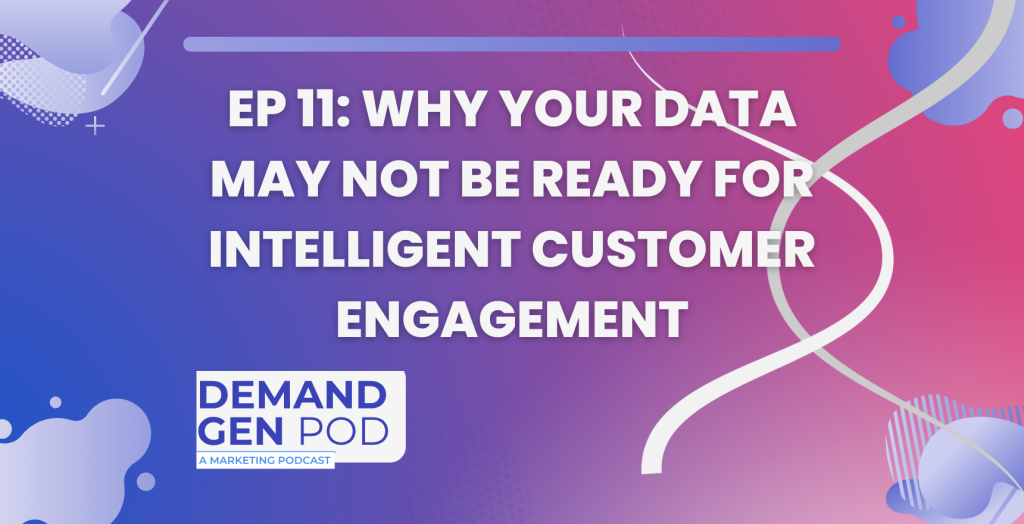Today on the Demand Gen Pod, Episode 11, Ryan hosts an episode of the DemandGen Pod focused on the power and importance of intent data in marketing and sales. He discusses how businesses can use intent data to gain insights, drive personalization, and enhance conversion rates, particularly in account-based marketing strategies. Key topics include the importance of data accuracy and completeness, data integration, cleansing and standardization, data strategy and governance, and data analytics and insights.
Ryan emphasizes the necessity of maintaining accurate and complete data to avoid poor decisions and wasted resources. He also highlights the role of data integration in ensuring data is connected and accessible across systems. He stresses the significance of data cleansing and standardization to improve data quality and consistency.
Ryan outlines the need for a robust data strategy and governance framework, which includes clear objectives, governance policies, and regular audits. He also touches on data analytics, mentioning tools like Power BI and Tableau for deriving actionable insights.
To assess and improve data readiness, Ryan advises conducting regular data audits and implementing data quality improvement initiatives. He concludes by urging businesses to prioritize data readiness for informed decision-making and personalized customer engagement, and he encourages listeners to subscribe to the podcast on various platforms.
Summary notes from Episode 11:
Certainly! Below is an outline with chapters and timestamps based on the
provided transcript: ### Outline: **Chapter 1: Introduction** \- 00:01 |
Welcome and Introduction **Chapter 2: Importance of Email Template Design** \-
00:04 | Significance of Email Template Design \- 00:20 | Understanding
Audience and Email Types **Chapter 3: Types of Email Templates** \- 00:29 |
Business-Oriented vs. Marketing Style Emails \- 00:48 | Text-Based Templates
for Sales \- 01:12 | Visuals and Brand Personality **Chapter 4: Consistent
Branding** \- 01:46 | Differentiating Email Types with Branding \- 02:21 |
Leveraging Colors and Design **Chapter 5: Mobile Responsiveness** \- 02:25 |
Importance of Mobile Responsiveness \- 02:35 | Optimizing for Mobile Devices
\- 03:04 | Designing for Mobile Responsiveness **Chapter 6: Structural
Considerations for Mobile** \- 03:14 | Layout Adjustments for Mobile \- 04:44
| Handling Images and Text on Mobile Devices **Chapter 7: Font Size and
Readability** \- 05:12 | Selecting Appropriate Font Sizes \- 05:39 | Ensuring
Readability for Older Audiences **Chapter 8: Clear and Compelling CTAs** \-
06:04 | Designing Effective CTAs \- 06:48 | Testing and Optimizing CTAs
**Chapter 9: Brand Consistency** \- 07:10 | Importance of Consistent Branding
\- 07:58 | Limiting Fonts and Font Sizes **Chapter 10: Enhancing Email Design
with Visuals** \- 08:30 | Utilizing Images and Visuals \- 08:58 | Creating
Visually Appealing Emails **Chapter 11: Testing and Optimization** \- 09:12 |
Importance of Testing and Optimization \- 09:37 | Evaluating Design
Effectiveness \- 09:59 | Multiple Links to Boost Click-Through Rates **Chapter
12: Accessibility Considerations** \- 10:25 | Using Alt Text for Images and
Links **Chapter 13: Personalization and Dynamic Content** \- 11:05 |
Leveraging Personalization and Dynamic Content **Chapter 14: Conclusion** \-
11:28 | Enhancing Customer Experience and Engagement \- 11:33 | Conclusion and
Contact Information This outline captures the key topics and corresponding
timestamps discussed in the meeting.
